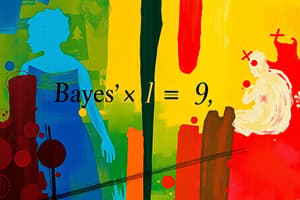Podcast
Questions and Answers
Vad är syftet med Bayes sats i maskininlärning?
Vad är syftet med Bayes sats i maskininlärning?
- Att optimera modeller genom att hitta den maximala posteriora estimaten (correct)
- Att visualisera data med hjälp av diagram
- Att beräkna sannolikheten för ett slag med enfair mynt
- Att identifiera mönster i data
Vilken typ av slumpmässig variabel kan ha ett oändligt antal värden?
Vilken typ av slumpmässig variabel kan ha ett oändligt antal värden?
- Diskret slumpmässig variabel
- Kontinuerlig slumpmässig variabel (correct)
- Binär slumpmässig variabel
- Kategorisk slumpmässig variabel
Vad visar en stapeldiagram?
Vad visar en stapeldiagram?
- Fördelningen av kontinuerliga data
- Förändringar i data över tid
- Sambandet mellan två kontinuerliga variabler
- Kategorierna av kategoriell data (correct)
Vad är P(A|B) i Bayes sats?
Vad är P(A|B) i Bayes sats?
Vad är Bayes sats användbart för?
Vad är Bayes sats användbart för?
Vilken typ av diagram visas sambandet mellan två kontinuerliga variabler?
Vilken typ av diagram visas sambandet mellan två kontinuerliga variabler?
Vad används histogram för att visa?
Vad används histogram för att visa?
Vad är villkorlig sannolikhet?
Vad är villkorlig sannolikhet?
Hur kan Bayes sats användas i maskininlärning?
Hur kan Bayes sats användas i maskininlärning?
Vad är en slumpmässig variabel?
Vad är en slumpmässig variabel?
Vad är en förutsättning för att använda Bayes sats?
Vad är en förutsättning för att använda Bayes sats?
Vad är syftet med Bayes sats i statistik?
Vad är syftet med Bayes sats i statistik?
Flashcards are hidden until you start studying
Study Notes
Statistics Probabilities: Bayes' Theorem and Random Variables
Probability is a fundamental concept in statistics that helps us understand uncertainty and make predictions. One of the most important principles in probability theory is Bayes' theorem, which provides a way to calculate the conditional probability of an event given other events. This theorem is essential in various fields, including machine learning and data analysis.
Bayes' Theorem
Bayes' theorem is a formula for calculating the conditional probability of an event, given its relationship to another event. It is widely used in probability and statistics to solve complex problems involving conditional probabilities. Here's an example of how Bayes' theorem can be applied:
-
Probability of Event A: This is the probability of an event occurring, regardless of the occurrence of another event. For instance, if we are interested in the probability of an event related to a coin toss, the probability of the coin landing heads up is 0.5 (assuming a fair coin).
-
Probability of Event B: This is the probability of another event occurring. For instance, if we are interested in the probability of an event related to a coin toss, the probability of the coin landing tails up is also 0.5 (assuming a fair coin).
-
Probability of Event B given Event A: This is the conditional probability of Event B occurring, given that Event A has occurred. For instance, if we are interested in the probability of an event related to a coin toss, the probability of the coin landing tails up, given that it landed heads up, is 0.5 (assuming a fair coin).
Bayes' theorem is written as:
P(A|B) = P(B|A) * P(A) / P(B)
where P(A|B) is the conditional probability of Event A given Event B, P(B|A) is the conditional probability of Event B given Event A, P(A) is the probability of Event A, and P(B) is the probability of Event B.
Random Variables
Random variables are variables whose values are determined by random events. They are used in statistics to model uncertain events and to calculate probabilities. Random variables can be discrete or continuous, depending on the range of possible values they can take.
-
Discrete Random Variables: These variables take on a countable number of possible values. For example, the number of heads obtained when flipping a coin a certain number of times is a discrete random variable, as it can only take on the values 0, 1, 2, ..., n, where n is the number of coin flips.
-
Continuous Random Variables: These variables take on an infinite number of possible values within a specific range. For example, the height of a person is a continuous random variable, as it can take on any value between 0 and infinity.
Data Visualization
Data visualization is a crucial aspect of statistics to help us understand and communicate complex data. Visual tools like charts, graphs, and diagrams can help us identify patterns, trends, and relationships in data. Some common data visualization techniques include:
-
Histograms: These graphs show the distribution of continuous data by dividing it into intervals and counting the number of observations in each interval.
-
Bar Charts: These charts display categorical data as rectangular bars with heights proportional to the values they represent.
-
Line Charts: These charts display changes in data over time by connecting data points with a continuous line.
-
Scatter Plots: These graphs display the relationship between two continuous variables by plotting the data as points on a two-dimensional coordinate system.
Bayes' Theorem in Machine Learning
Bayes' theorem is widely used in machine learning for tasks such as classification, prediction, and optimization. For example, it can be used to develop models for classification problems, such as the Bayes Optimal Classifier and Naive Bayes Classifier. It can also be used to optimize models by finding the maximum a posteriori (MAP) estimate, which is the most likely value of a parameter given the observed data.
Conclusion
In conclusion, probability, Bayes' theorem, and random variables are essential concepts in statistics and data analysis. Understanding these concepts can help us make predictions, model uncertain events, and interpret complex data. By combining these tools with data visualization techniques, we can gain valuable insights into the world around us.
Studying That Suits You
Use AI to generate personalized quizzes and flashcards to suit your learning preferences.




